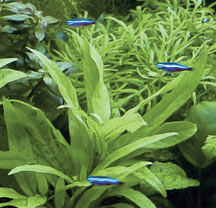|
Aquarium aesthetics compromised by persistent algae is a common annoyance for most hobbyists. It is easy to regard algae as the problem, but aggressive algae growth is merely a symptom of a series of underlying water quality issues. Attempts at controlling algae are often unsuccessful if the root causes are not identified.
WHAT ENCOURAGES AGGRESSIVE ALGAE GROWTH?
Algae are prolific and opportunistic organisms that take advantage of aquarium systems that are out of balance. Water quality issues including excess nutrients, poor water movement, and insufficient aeration create ideal conditions for algae. Alone, these water quality issues may seem minor, but when combined they create an imbalance that favors aggressive algae growth. Therefore, the most effective approach to algae control is a multifaceted one that properly addresses each water quality issue.
EXCESS NUTRIENTS
Begin your algae-control regimen by monitoring fish feedings. Your fish should be able to completely finish their food within a few minutes. If not, you are feeding them too much. Overfeeding is probably the most common source of excess nutrients. It may seem like a harmless oversight, but overfeeding triggers a series of events that affect water quality. As uneaten food breaks down, it releases a variety of algae-fueling nutrients including nitrogen compounds and phosphate. Large, well-fed fish produce more organic waste to further increase the food supply for algae.
OTHER NUTRIENT SOURCES
Nutrient sources for algae are not limited to just fish food. Many common algal nutrients may be lurking right in your source water. Depending on your source water, you may be inadvertently introducing nitrogen compounds (ammonia, nitrite, nitrate), phosphate, silicate, or iron into your aquarium. Regular
routine water changes are recommended to remove or dilute nutrient concentration in aquariums, but if these nutrients are present in your source water, you may be fighting a losing battle.
Use aquarium test kits to determine if your source water contains ammonia, nitrite, nitrate, phosphate, silicate, or iron. If test results are positive, there are several steps you can take to remedy the situation. However, the most comprehensive and effective approach is to employ a Reverse Osmosis (RO) unit. RO units are designed to remove the majority of tap water impurities to produce pure water.
POOR WATER MOVEMENT
Aquariums with poor or inadequate water movement create protected areas where algae can establish. Waste materials settle and accumulate in these "dead spots" and create a nutrient-rich foundation for algae. Improving water movement through the use of powerheads reduces the buildup of waste materials and allows filtration devices to work more efficiently. The moving water helps transport more waste materials to the filter where they are mechanically removed from the water column. However, it is essential to clean or replace mechanical filter media on a regular basis. If not, the trapped organic debris will break down and release dissolved organic nutrients back into the aquarium.
INSUFFICIENT AERATION
Proper aeration plays a critical role in algae control. Aeration devices allow efficient gas exchange where carbon dioxide is released from the water and fresh air and oxygen is introduced. Since algae require carbon dioxide to thrive, reducing the supply of carbon dioxide limits algae growth.
REGULAR ROUTINE MAINTENANCE
Simply put, there is no avoiding regular routine maintenance. Partial water changes (25% every 1-2 weeks) reduce and dilute the concentration of aquarium pollutants and excess algal nutrients. Use an algae scraper to physically remove algae from surfaces and whenever possible, siphon out the algae debris.
 ADDITIONAL ALGAE CONTROL TIPS
ADDITIONAL ALGAE CONTROL TIPS
- Supplement your existing algae control regimen with an ultraviolet sterilizer. UV sterilizers emit UVC light to help prevent stubborn, free-floating algae from multiplying.
- Enhance water quality with phosphate-removing chemical filter media. These specialized media effectively remove phosphate and other dissolved aquarium pollutants.
- Employ biological algae control. Add live plants to naturally reduce algal nutrients. To clean up uneaten food, consider catfish and other bottom feeders. Better yet, stock your aquarium with herbivores and algae eaters. For marine aquariums, grow beneficial macroalgae in a refugium.
- When trying to control algae, pay special attention to water parameters and fish health. Don't be surprised to find out algae may actually be benefiting your aquarium by processing excess nutrients and providing supplemental oxygen and food for fish.
Question:
I use a liquid algae control solution and it works great, but why does the algae keep coming back? |
Answer:
Algae control solutions are most effective when used as part of a comprehensive algae control regimen. Unless the underlying water quality issues are properly addressed, the benefits of algae control solutions will be limited. |
|